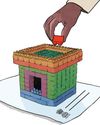
I WOULD have never tried grass pea had an acquaintance not brought me some from her village in Jharkhand. The legume (Lathyrus sativus), also known as khesari dal in Hindi, lang in Marathi and laag in Gujarati, has been infamous for causing lathyrism, an irreversible neurological disease that leads to paralysis of lower limbs. But my acquaintance assured me that people in her village consume it regularly.
Traditionally, the legume, which resembles toor dal (pigeon pea), is consumed in the form of sattu, a protein-rich flour made from a mixture of pulses and cereals, added with wheat flour to make rotis and puris, or simply boiled to prepare a dal. On my acquaintance's suggestion, I used the grass pea to make pakoris (fritters) and added them to a potato curry (see recipe).
PERSISTENT PRESENCE
The use of grass pea is common among the poor, since it is one of the cheapest legumes and grows easily in fallow fields, can be rotated with any crop and needs little to no investment. It is also tolerant to drought, salinity and water logging and resistant to pests and biotic stress. In terms of nutrition, grass pea has high levels of proteins, second only to soybean, and even has the compound L-homoarginine that is beneficial to heart health.
This story is from the November 16, 2023 edition of Down To Earth.
Start your 7-day Magzter GOLD free trial to access thousands of curated premium stories, and 8,500+ magazines and newspapers.
Already a subscriber ? Sign In
This story is from the November 16, 2023 edition of Down To Earth.
Start your 7-day Magzter GOLD free trial to access thousands of curated premium stories, and 8,500+ magazines and newspapers.
Already a subscriber? Sign In

Vision 2030
Economic growth must take into account needs of energy transition, climate mitigation, with action aligned as per India's 2030 climate goals

FIX OUR FOOD
Chemical-dependent farming, lax labelling laws, rising anti-microbial resistance must top the agenda

BATTLE THE CAR BULGE
Clean, affordable, integrated and accessible public transport the only solution

CONSERVE NOW
Disregard for biodiversity conservation over the past two decades needs immediate redressal

SCRAP THE DUMP
Disincentivise garbage dumping, invest in behavioural change

PLAN THEM COOL
As urban India turns into a heat trap, the government must focus on improving cities' liveability

THINK LONG-TERM
India needs continued emphasis on flagship programmes, aligned to long-term planning that focusses on water security and circular economy in a climate-risked era

OVERHAUL OVERDUE
Hold polluting industries accountable for public health risks, environmental hazards, climate change; provide them support for green transition

LOOK BEYOND DUST
Reinvent National Clean Air Programme to focus on fine particulate matter and trans-boundary pollution

IT'S NOW OR NEVER
Clean energy sectors need demand-driven markets and domestic industries that can cater to the entire value chain